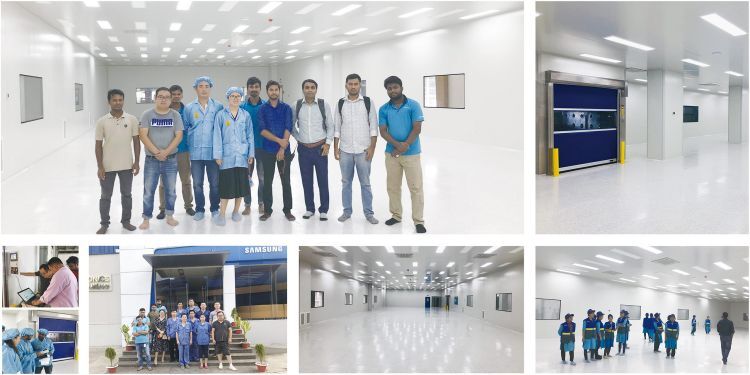Cleanroom Workshop: Maintaining the Highest Level of Cleanliness in Manufacturing
- 2024-01-31
- View 11
Cleanroom workshops are specially designed manufacturing spaces that require strict control of environmental factors such as air quality, temperature, humidity, and particulate contamination Cleanrooms are used in a wide range of industries, including electronics, pharmaceuticals, medical device manufacturing, and biotechnology. The goal of a cleanroom workshop is to maintain a high level of cleanliness and prevent any contamination of products, components, or processes.
In this article, we will discuss the importance of cleanroom workshops, the standards and classifications of cleanrooms, the design and construction of cleanrooms, and the equipment and procedures used in maintaining a cleanroom environment We will also cover the benefits of cleanroom workshops, including improved product quality, increased yield, and reduced costs.

Importance of Cleanroom Workshops
Cleanroom workshops are essential in industries where the production of high-quality and contamination-free products is critical. In electronic manufacturing, for instance, even the smallest amount of dust can cause defects in electronic components, resulting in costly production failures. In pharmaceuticals and biotechnology, contaminated products can be dangerous to consumers, leading to severe health issues. The goal of a cleanroom workshop is to eliminate or reduce the risk of contamination and ensure the highest level of quality in the manufacturing process.
Standards and Classifications of Cleanrooms
Cleanrooms are classified based on the number and size of particles allowed per cubic meter of air. The classification system is based on the ISO standard 14644-1, which ranges from ISO 1 (fewest particles) to ISO 9 (most particles). Each class has a maximum allowable particle count per cubic meter of air, and the level of cleanliness required depends on the specific industry and product being manufactured.
Design and Construction of Cleanrooms
Cleanroom design and construction require strict adherence to industry standards and regulations. Cleanrooms are typically constructed as a sealed environment with a controlled air filtration system. Walls, floors, and ceilings are made of non-porous materials that can be easily cleaned and disinfected. The entry and exit points are also specially designed to prevent the entry of contaminants.
Equipment and Procedures in Maintaining a Cleanroom Environment
Maintaining a cleanroom environment requires specialized equipment and procedures. Cleanroom operators must wear protective clothing, including gloves, coveralls, and masks. Equipment used in the cleanroom must be specially designed and constructed to minimize the risk of contamination. The air filtration system must be regularly monitored and maintained to ensure the proper air quality and prevent the entry of contaminants.
Benefits of Cleanroom Workshops
Cleanroom workshops provide numerous benefits, including improved product quality, increased yield, and reduced costs. By eliminating or reducing the risk of contamination, manufacturers can produce high-quality products that meet or exceed industry standards. Increased yield and reduced costs are also benefits of cleanroom workshops, as the production of defective products is minimized, and product development timelines are shortened.
FAQs
Q1. What industries use cleanroom workshops?
A1. Cleanroom workshops are used in industries such as electronics, pharmaceuticals, medical device manufacturing, and biotechnology.
Q2. What is the goal of a cleanroom workshop?
A2. The goal of a cleanroom workshop is to maintain a high level of cleanliness and prevent any contamination of products, components, or processes.
Q3. How are cleanrooms classified?
A3. Cleanrooms are classified based on the number and size of particles allowed per cubic meter of air, ranging from ISO 1 (fewest particles) to ISO 9 (most particles).
Q4. How are cleanrooms designed and constructed?
A4. Cleanrooms are designed and constructed as sealed environments with controlled air filtration systems. Walls, floors, and ceilings are made of non-porous materials that can be easily cleaned and disinfected.
Q5. What are the benefits of cleanroom workshops?
A5. Cleanroom workshops provide numerous benefits, including improved product quality, increased yield, and reduced costs. By eliminating or reducing the risk of contamination, manufacturers can produce high-quality products that meet or exceed industry standards. Increased yield and reduced costs are also benefits of cleanroom workshops, as the production of defective products is minimized, and product development timelines are shortened.
In conclusion, cleanroom workshops are critical in industries that require the production of high-quality and contamination-free products. By implementing and adhering to industry standards and regulations, manufacturers can improve product quality, increase yield, and reduce costs. Cleanroom workshops require specialized equipment, procedures, and trained operators to maintain the highest level of cleanliness and prevent any contamination of products, components, or processes.
Kwang Cleanroom is proud to offer examples of a variety of our cleanroom projects below. Cleanroom ISO Standards, Clean Room in Pharmaceutical Industry, Ultra Clean Room Systems, Cosmetics Clean Room Engineering, Operating Room Purification Engineering, Clean Room Cost, Cleanroom Workshop Maintenance.
